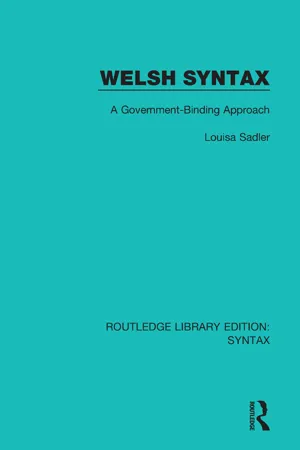This chapter is largely descriptive in nature, providing a backdrop to the more intricate analyses presented in later chapters, which build on the proposals made here for the analysis of basic clause structure in Welsh. Two points of theoretical interest are raised in Chapter One. The first concerns the degree of abstractness required to establish the basic phrasal configurations of Welsh. Despite the surface VSO characteristics of Welsh, I shall argue that the postulation of a VP node is well motivated in both D– and S–structure. A similar analysis has been presented for Irish in McCloskey (1983a). The second point concerns the INFL node. The analysis presented here provides further support for the existence of INFL. It is argued that the two basic word order patterns in finite clauses follow from the operation of a V–fronting rule, moving V into INFL. In some sense, then, the material in this chapter represents certain theoretical commitments in the analysis of VSO languages.
1.1. BASIC WORD ORDER
One of the most important considerations with regard to the analysis of Welsh in a government and binding framework is the question of word order. The proposed universal base rule of Chomsky (1981), for example, assumes that underlyingly at least, every configurational language has a VP.
There are two basic patterns in Welsh finite clauses; an S–initial inflected verb is common to both:
(1) V S O X
V S V O X
The first of these, the simple clause, may be used when tense, but not aspect is expressed:
In such aspectless clauses, the second, or periphrastic, form is also available:
There is no perceptible semantic difference between these two patterns as illustrated in (2) and (3) above, and gwneud (do) is generally regarded as a carrier auxiliary. The main difference between these forms is stylistic, and will be ignored here. In written Welsh, the pattern illustrated by (2) is more extensively used, whereas the periphrastic predominates in spoken Welsh.1
In addition, periphrastic forms are used to express combinations of tense and aspect:
A periphrastic construction may contain a number of aspectual, modal and carrier verbs, the first of which will carry tense marking, while the main verb itself is obligatorily untensed, and final in the verb group. Aspectual periphrastic constructions such as that illustrated in (5) involve inflected forms of bod (be) in S–initial position, the main verb being preceded by an aspect marker in post–subject position. Where aspect markers co–occur, each is accompanied by a form of bod:
The ordering bod wedi – bod yn is invariable. The ordering of modals and carrier auxiliaries such as gwneud with respect to the aspectual auxiliaries is presented in Section 1.2.
Common to both the simple and periphrastic clause is the fact that the inflected verb precedes the subject NP. On the basis of the simple clauses, Welsh is generally classified as a VSOX language. In fact, Welsh conforms to those aspects of syntactic structure which Greenberg (1963) argues are characteristic of languages with surface VSO word order. The brief illustration provided here is based on McCloskey (1983a) which discusses the same facts for Irish.3
Welsh has prepositions not postpositions (universal 3):
A clause–initial question particle occurs...






